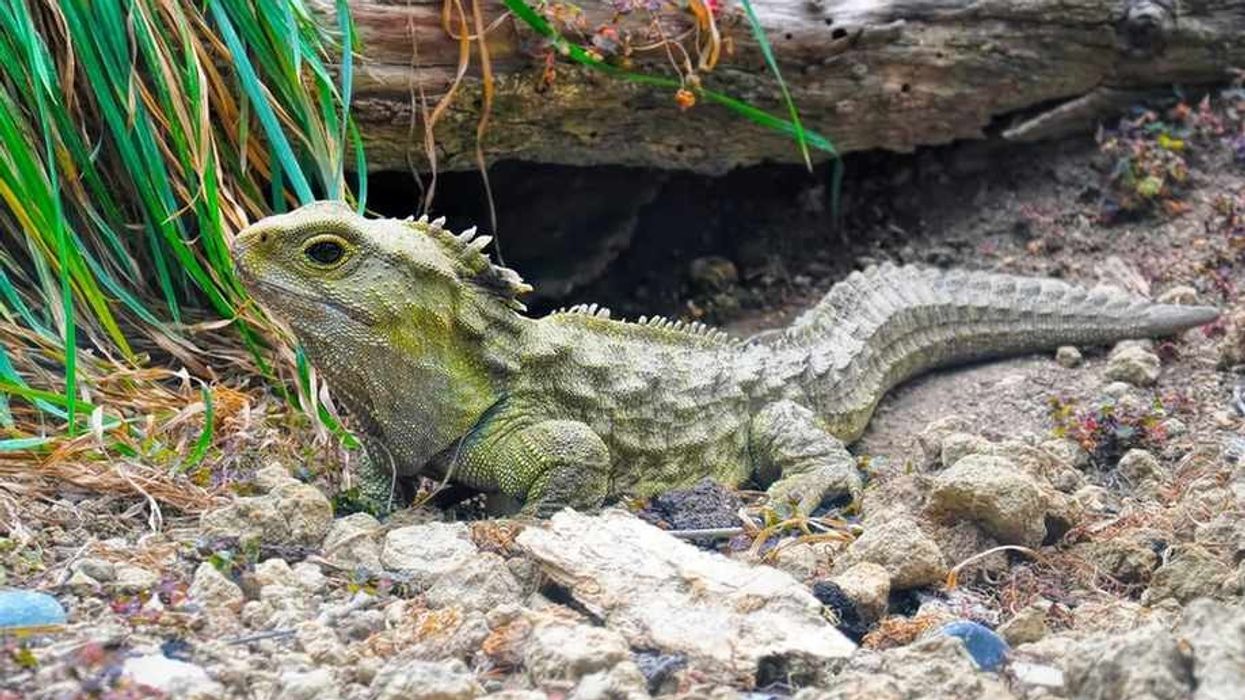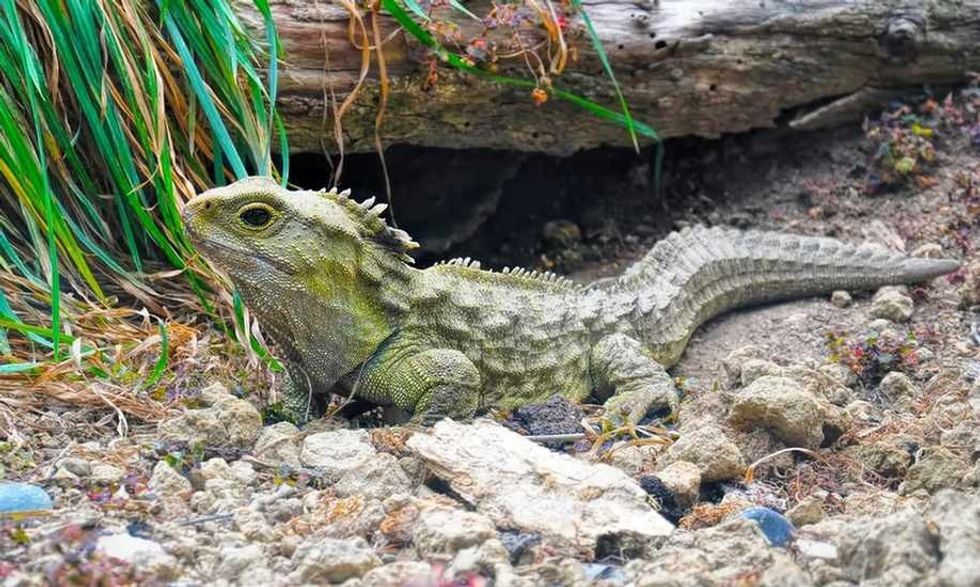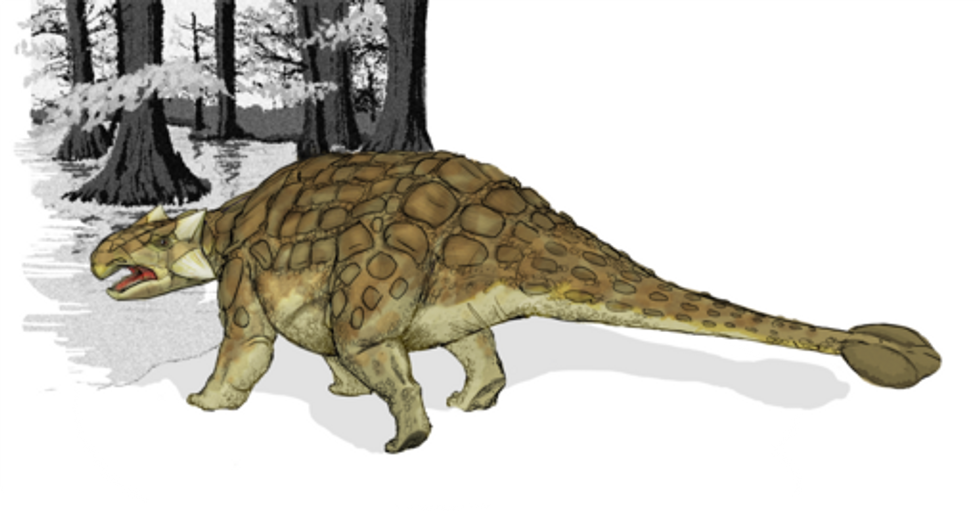Tuatara (Sphenodon punctatus) are lizard-like animals that are the only survivor species of an ancient group of reptiles. They are also known as living fossils.
It is thought that they existed around 200 million ago and the Sphenodon punctatus, tuatara, is the only remaining member of related reptiles. Tuataras are specifically found in the region of New Zealand and species of tuatara are in need of active conservation.
The tuatara is a reptile but it isn't quite a lizard or a snake or a dinosaur. Scientists are still finding out and studying about them because they can teach us about how modern-day lizards and snakes evolved.
The tuatara has another fascinating feature which is their third eye.
Yes, they have a third eye or otherwise known as a 'parietal eye' on the top of their heads. Owing to having peaks on the back, the tuatara got their unique name which is derived from the Māori language and means 'peaks on the back'.
Tuataras are generally greenish-brown and gray in color or olive green too, and can measure up to 80 cm in length from head to tail-tip and weigh up to 1.3 kg.
There is some speculation that there are two species of tuatara present, namely the Sphenodon punctatus, or northern tuatara, and the much rarer Sphenodon guntheri, or Brothers Island tuatara.
New Zealand's tuatara lizard is one of the most unique animals left in the world.
These are found in the part of the offshore island of New Zealand. Tuataras are solitary in nature and live in burrows to keep their body temperatures normal.
Read on for more fascinating facts about the tuatara (Sphenodon punctatus). You may also like our facts on the Caiman lizard and Olive Ridley sea turtle.
Tuatara Interesting Facts
What type of animal is a tuatara?
The tuatara is a very unique creature found in parts of New Zealand. There have been constructive studies going on regarding the tuatara's origin. It is thought to have relations with dinosaurs, snakes, and lizards.
What class of animal does a tuatara belong to?
The tuatara classification is quite complex. They are reptiles who are similar to lizards but do not belong to the same class, and also bear resemblances to dinosaurs.
How many tuataras are there in the world?
The count of tuataras is very small at present. They are only in the native country i.e. New Zealand. It is estimated that only about 55,500 tuataras are present on the mainland.
Where does a tuatara live?
The tuataras are basically found in the mainland of New Zealand and more exactly in some parts of offshore islands which are either woodland and grassland. These two native places are where these species can be found easily.
What is a tuatara's habitat?
Tuatara populations belong to the islands of New Zealand. The tuatara habitat mainly consists of grassland and woodland. They create a hollow of their own.
Who do tuataras live with?
Tuataras live offshore of the mainland island of New Zealand where they actually create their own nest for both males and females to live in. There, they also lay eggs, but sometimes the tuataras even prefer to live with or share the nest with sea birds.
How long does a tuatara live?
Amazingly, studies have shown that the tuatara lifespan is more than 100 years. Yes, you heard it right, more than 100 years! However, due to other factors, the average might be said to be more like 60 years.
How do they reproduce?
The process of reproduction in tuataras is pretty slow when comparing to other animals or species of their similarity. Usually, they take around 10-20 years to reach sexual maturity.
The mating season occurs during midsummer and the females lay 12 eggs on an average, once every four years.
During the time of intercourse, the male tuatara (Sphenodon punctatus) makes his skin darker, raises his crests, and walks towards females. In the next step, either the females submit or allow the males to mount on them.
The tuatara males have rudimentary hemipenes that are intromittent organs used to put the sperm inside the females during intercourse. They reproduce through the process known as a 'cloacal kiss' where the male lifts the tail of the females placing his vent on hers.
The sperm is then transferred into the females.
The female sometimes stores tuatara eggs up to a year and then use it to fertilize a batch which can range in number from a single egg up to 19 eggs. The normal time for incubation of tuatara eggs lasts about 12 to 15 months, which is considered a long period of time, in reptiles.
What is their conservation status?
The count of tuataras is very small at present and is only in their native country New Zealand. Even there, on the mainland and offshore islands the tuatara (Sphenodon punctatus) is not great in number.
The conservation status of the tuatara (Sphenodon punctatus) is at Neart Threatened although there are some in the zoo where they have been kept safe.
Tuatara Fun Facts
What do tuataras look like?
The males and females of tuataras are almost similar in looks or color. Their skin is made of scales and mostly found in muted, olive green, or rusty brown color which also helps them to blend in with their surrounding as well.
They have the ability to change their color with respect to time or atmosphere. Talking about the males, they have a large, distinctive crest of spines along their backs and necks which makes them distinctive from females.
There's a tuatara teeth fact which makes them look different as the tuatara's teeth are very unusual and can't be replaced.
They have a single jaw bone or row of teeth on the lower jaw and a double row or bone of teeth on the upper jaw. It's a unique tooth arrangement and is not seen in any other reptile

How cute are they?
These creatures have a look that is a mixture of reptiles, snakes, and dinosaurs, which is intriguing but perhaps less likely to be considered as cute. Their beady eyes, however, could be seen as cute.
How do they communicate?
There are no such specific ways yet that have been discovered through which tuataras communicate, although studies have been going around for a while to understand the actual behavior of tuataras.
How big is a tuatara?
Compared to the length of the other animals found in the tuatara's habitat, other similar-looking reptiles are considered to be smaller from the front than them.They are expected to get pretty big with a length of 31 in (80 cm).
How fast can a tuatara move?
The top speed with which tuataras can run is estimated at around 15 mph. It is the fastest speed at which these species or animals can travel and it is mostly done to save themselves from different introduced predators such as rats and dogs which are the biggest threat to them.
How much does a tuatara weigh?
The weight of tuataras is to be considered the heaviest amongst the reptiles and is around 2.9 lb (1.3 kg).
What are their male and female names of the species?
There are no such individual names for the genders of the species of tuataras, only they have clear differentiation in their body.
What would you call a baby tuatara?
There is no specific name for the young ones, but they have very distinctive features such as teeth that grow very quickly.
Other than that there are more interesting facts about tuatara young ones like that the mother tuatara doesn't stay around to protect the eggs or the babies once they have hatched. Another interesting fact about tuatara young ones is that their sex is determined with the help of temperatures of the incubating nest during the time of hatching.
This process or phenomenon is known as 'temperature-dependent sex determination.'
What do they eat?
Talking about the tuatara diet, being the most unique creature of the world whilst also being similar to creatures like lizards, they also eat similar food to them like insects such beetles, worms, crickets, and spiders. Sometimes they have also seen eating snails, frogs, bird eggs, skinks, and even their own young.
Are they poisonous?
No, they are not yet known to be poisonous. Although some of the lizards and reptiles found in the world are poisonous there are no known traces of tuataras being poisonous.
Would they make a good pet?
This totally depends on the choice of the owner who wants to have an animal that is neither lizard nor snake. It is also a very rare and unique creature on the planet earth.
We wouldn't suggest having them as a pet because the tuatara populations are already very decreased in count and there might be certain rules regarding the tuataras in New Zealand which will definitely not allow you to have a tuatara pet.
Did you know...
Here are some great tuatara facts for kids that will surprise you!
Depending on the habitat, these lizards can actually change the color of their body from different variants such as greenish-brown or gray-colored.
The tuatara has crest is especially significant in males as they use it to attract females during the breeding season.
The tuatara uses it's third eye to detect daily changes in light and seasonal changes.
Tuataras are cannibals too which means they can eat their own kind.
During the time of winter, tuataras hibernate to avoid low temperatures and lack of food and that is why the mating season of tuataras takes place during the summer.
Amazingly there is a tuatara living in New Zealand which is the known oldest tuatara reptile living on the earth. His name is Henry, and he is almost 110 years old. He is currently living in New Zealand's museum. Henry has almost 80 babies to date which are all healthy and protected by the New Zealand government.
Why are tuataras not lizards?
Chasing down the ancestor history of tuataras is a tough and big task because they have a very long history. They are actually grouped under their own order, Rhynchocephalia, which means 'beak head,' and are the only living animals present in this order.
The tuataras are still reptiles so they share similarities with lizards and snakes, but they are not actually related. They are thought of as possibly being dinosaurs in today's world because they have remained the same over years and years.
How many eyes does a tuatara have?
Unlike other animals or reptiles, the tuataras have a third eye which is sometimes termed as tuatara third eye, or scientifically known as tuatara parietal eye on the top of the tuatara skull, but it is very small and difficult to notice.
Like the other studies going on tuataras scientists are also studying to know why tuataras have this third eye, but there are many speculations that it is used to determine cycles of light and dark.
Also, it could be present in helping them absorb the UV lights to regulate their body temperatures.
Here at Kidadl, we have carefully created lots of interesting family-friendly animal facts for everyone to discover! Learn more about some other reptiles including sand lizard facts, or bog turtle.
You can even occupy yourself at home by drawing one on our Tuatara coloring pages.










